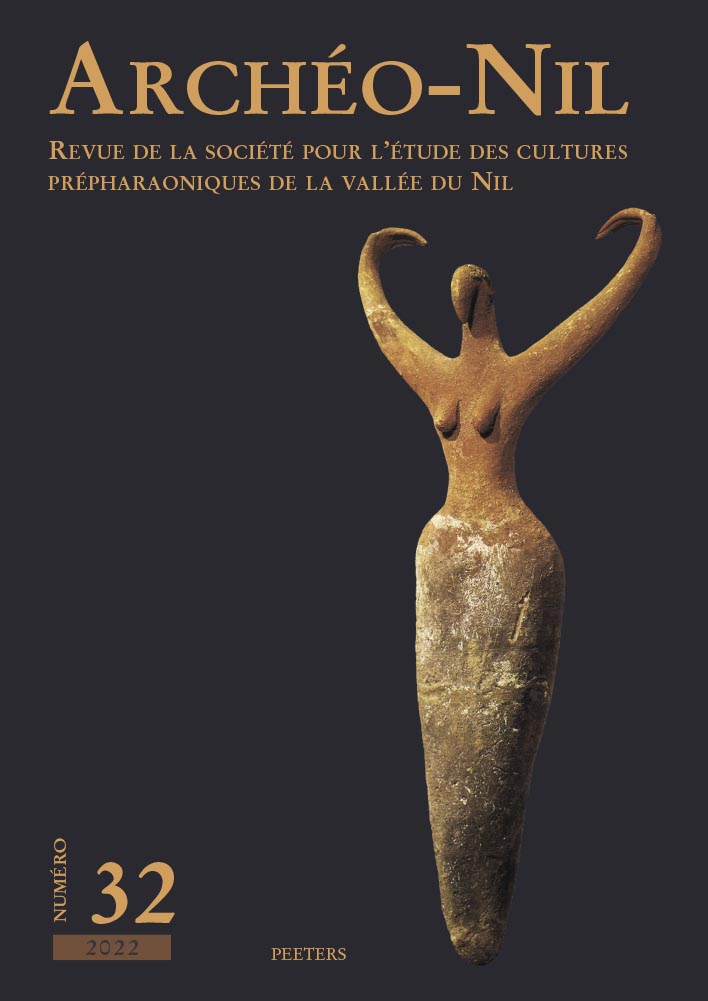 previous article in this issue previous article in this issue | next article in this issue  |

Preview first page |
Document Details : Title: Who was the Master of Animals? Subtitle: A View from (and into) the Margins Author(s): CAMPAGNO, Marcelo , MAYDANA, Sebastián Journal: Archéo-Nil Volume: 33 Date: 2023 Pages: 31-42 DOI: 10.2143/ANI.33.0.3292015 Abstract : Most discussions involving the Master of Animals motif in the late Predynastic Period of Egypt have dealt primarily with its origins and diffusion, almost invariably stressing its ties to Mesopotamia. In this article, the authors examine the corpus of representations of this motif as a whole, concluding that the Master of Animals motif belongs to a larger tradition or ‘cultural substrate’ that encompasses the macro-area of Northern Africa and the Levant, and suggesting that each instance of the motif served different purposes and had different meanings and interpretations depending on the setting. In the Nile Valley, the period in which this motif appears is also when new forms of leadership arise, and the known examples mostly come from the contemporary seats of power. An analysis of the specific features of the Master himself reveals that he is depicted as a solitary man who completely controls the non-human world, a world with which he has a special and unique relationship. From this analysis stems the conclusion that his ‘otherness’ is stressed, not just regarding animals, but also the rest of society, as it happens within the context of African sacred leadership. The sacred leader is such because he is stripped of his kinship ties, becoming an Other regarding his original community. In a similar way, the Master of Animals is an Other with respect to the animals he controls, but for that very reason he can be an Other, a marginal being capable of controlling people of a community to which he does not belong. Thus, the motif of the Master of Animals in the late Predynastic context can be understood as a visual expression of the aspirations of emerging elites to control both the human and the non-human worlds, or at least of presenting themselves as being capable of such undertakings. La plupart des discussions concernant le motif du maître des animaux à la fin de la période prédynastique en Égypte ont porté principalement sur ses origines et sa diffusion, en soulignant presque invariablement ses liens avec la Mésopotamie. Dans cet article, les auteurs examinent le corpus de représentations de ce motif dans son ensemble, concluant que le motif du maître des animaux appartient à une tradition plus large ou à un «substrat culturel» qui englobe la macro-région de l’Afrique du Nord et du Levant, et suggérant que chaque instance du motif servait des objectifs différents et avait des significations et des interprétations différentes selon le contexte. Dans la vallée du Nil, la période d’apparition de ce motif correspond également à l’apparition de nouvelles formes d’autorité, et les exemples connus proviennent pour la plupart des sièges du pouvoir contemporains. Une analyse des caractéristiques spécifiques du maître lui-même révèle qu’il est dépeint comme un homme solitaire qui contrôle complètement le monde non humain, un monde avec lequel il entretient une relation spéciale et unique. De cette analyse découle la conclusion que son «altérité» est soulignée, non seulement à l’égard des animaux, mais aussi du reste de la société, comme cela se produit dans le contexte du pouvoir sacré africain. Le chef est sacré parce qu’il est dépouillé de ses liens de parenté, devenant un Autre par rapport à sa communauté d’origine. De la même manière, le maître des animaux est un Autre par rapport aux animaux qu’il contrôle, mais pour cette même raison, il peut aussi être un Autre au sens d’un être marginal capable de contrôler les gens d’une communauté à laquelle il n’appartient pas. Ainsi, le motif du maître des animaux dans le contexte prédynastique tardif peut être compris comme l’expression visuelle des aspirations des élites émergentes à contrôler à la fois le monde humain et le monde non humain, ou du moins à se présenter comme capables de telles entreprises. |
|


